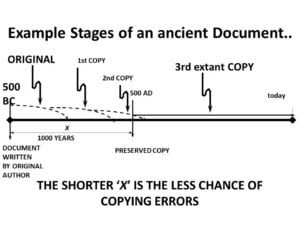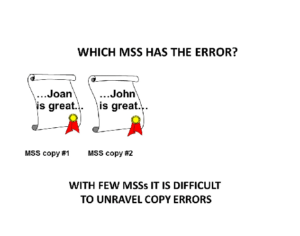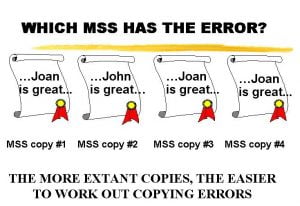Textual Criticism and the Bible (al-Kitab)

In our scientific and educated age, we question many of the non-scientific beliefs that earlier generations had. This scepticism is especially true of al-Kitab, the Bible. Many of us question the reliability of al-Kitab from what we know about it. After all, al-Kitab was written more than two thousand years ago. But for most of these millennia, there was no printing press, photocopy machines or publishing companies. So the original manuscripts were copied by hand, generation after generation. Concurrently, languages died out and new ones arose, empires changed and new powers ascended.
Since the original manuscripts have long been lost, how do we know that what we read today in al-Kitab is what the original authors actually wrote? Perhaps al-Kitab was changed or corrupted. Maybe church leaders, priests, bishops, or monks did so because they wished to change its message for their purposes.
Principles of Textual Criticism
Naturally, this question is true of any ancient writing. Textual Criticism is the academic discipline of determining whether an ancient text has changed from its original composition until today, and since it is an academic discipline it applies to any ancient writing from any language. This article explains some basic principles of Textual Criticism and applies them to al-Kitab to determine its reliability.

This diagram shows an example of a hypothetical document written in 500 BCE. The original text did not last long – so before it decays, is lost, or is destroyed, a manuscript (MSS) copy of it must be made (first copy). Generally, a professional class of people called scribes did the copying. As the years advance, scribes make copies (second and third copies) of the first copy. At some point, a copy is preserved so that it exists today (the third copy).
Principle 1: Manuscript Time Intervals

In our example diagram, scribes produced this existing, or extant, copy in 500 CE. So this means that the earliest that we can know of the state of the text is only after 500 CE. Therefore the time from 500 BCE to 500 CE (labelled x in the diagram) forms the period of textual uncertainty. Even though the original was written long before, all manuscripts before 500 CE have vanished. Therefore we cannot evaluate copies from this period.
Thus, the first principle used in textual criticism is to measure this time interval. The shorter this interval x, the more confidence we can place in the correct preservation of the document to our time since the period of uncertainty is reduced.
Principle 2: The number of existing manuscripts

The second principle used in Textual criticism is to count the number of existing manuscripts today. Our example illustration above showed that only one manuscript is available (the 3rd copy). But usually, more than one manuscript copy exists today. Therefore, the more manuscripts in existence in the present day, the better the manuscript data. Then historians can compare copies against other copies to see if and how much these copies deviate from each other. So the number of manuscript copies available becomes the second indicator determining the textual reliability of ancient writings.
Textual Criticism of Classical Greco-Roman writings compared to the New Testament
These principles apply to any ancient writings. So let us now compare New Testament manuscripts with other ancient manuscripts that scholars accept as reliable. This Table lists some well-known ones:
| Author | When Written | Earliest Copy | Time Span | # |
| Caesar | 50 BCE | 900 CE |
950 |
10 |
| Plato | 350 BCE | 900 CE |
1250 |
7 |
| Aristotle (from any one work) | 300 BCE | 1100 CE |
1400 |
5 |
| Thucydides | 400 BCE | 900 CE |
1300 |
8 |
| Herodotus | 400 BCE | 900 CE |
1300 |
8 |
| Sophocles | 400 BCE | 1000 CE |
1400 |
100 |
| Tacitus | 100 CE | 1100 CE |
1000 |
20 |
| Pliny | 100 CE | 850 CE |
750 |
7 |
McDowell, J. Evidence That Demands a Verdict. 1979. p. 42-48
These writers represent the major classical writers of antiquity. Basically, their writings shaped the development of today’s civilization. But on average, they have been passed down to us by only 10-100 manuscripts. Moreover, the earliest existing copies are preserved starting about 1000 years after the original was written. We treat these as our control experiment since they comprise writings that form the foundation of history and philosophy. So academics and universities worldwide accept, use and teach them.
New Testament Manuscripts
The following table compares the New Testament (Injil) manuscripts along the same principles of Textual Criticism. Then we will compare this to our control data, just like in any scientific investigation.
| MSS |
When Written |
Date of MSS |
Time Span |
| John Rylan | 90 CE | 130 CE |
40 yrs |
| Bodmer Papyrus | 90 CE | 150-200 CE |
110 yrs |
| Chester Beatty | 60 CE | 200 CE |
140 yrs |
| Codex Vaticanus | 60-90 CE | 325 CE |
265 yrs |
| Codex Sinaiticus | 60-90 CE | 350 CE |
290 yrs |
Comfort, P.W. The Origin of the Bible, 1992. p. 193
However, this table gives just a brief highlight of some of the existing New Testament manuscripts. The number of New Testament manuscripts is so vast that it would be impossible to list them in one table.
Testimony of the Scholarship
As one scholar who spent years studying this issue states:
“We have more than 24000 MSS copies of portions of the New Testament in existence today… No other document of antiquity even begins to approach such numbers and attestation. In comparison, the ILIAD by Homer is second with 643 MSS that still survive”
McDowell, J. Evidence That Demands a Verdict. 1979. p. 40
A leading scholar at the British Museum corroborates this:
“Scholars are satisfied that they possess substantially the true text of the principal Greek and Roman writers … yet our knowledge of their writings depends on a mere handful of MSS whereas the MSS of the N.T. are counted by … thousands”
Kenyon, F.G. (former director of British Museum) Our Bible and the Ancient Manuscripts. 1941 p.23
New Testament Textual Criticism and Constantine
Significantly, a large number of these manuscripts are extremely ancient. For example, consider the introduction of the book transcribing the earliest Greek New Testament documents.
“This book provides transcriptions of 69 of the earliest New Testament manuscripts…dated from early 2nd century to beginning of the 4th (100-300AD) … containing about 2/3 of the new Testament text”
Comfort, P.W. “The Text of the Earliest New Testament Greek Manuscripts”. p. 17. 2001
This is significant because these manuscripts come before Roman Emperor Constantine (ca 325 CE). They also precede the rise to power of the Catholic Church. Some wonder whether either Constantine or the Catholic Church altered the biblical text. We can test this by comparing the manuscripts from before Constantine (325 CE) with those coming later. However, we find that they have not changed. The manuscripts from, say 200 CE, are the same as those that come later.
Thus, neither the Catholic Church nor Constantine changed al-Kitab. This is not a religious statement but is based solely on the manuscript data. The figure below illustrates the timeline of manuscripts from which today’s New Testament comes from.

To summarize, neither time nor Christian leaders have corrupted the original ideas and messages that were first placed into the original writings of al kitab or the Bible. We can know that al Kitab today accurately reads what the authors actually wrote from the many thousands of early manuscripts that we have today. The science of Textual criticism supports the reliability of al Kitab (the Bible).
I had the privilege to give a public lecture on this topic at the University of Western Ontario in Canada not too long ago. Below is a 17-minute video of the part of the lecture that covers this question.
Implications of al-Kitab Textual Criticism
So what can we conclude from this? Certainly at least in what we can objectively measure (number of extant MSSs and time spans between original and earliest extant MSS) the New Testament (Injil) is supported much more than any of the other classical writings. The verdict to which the evidence pushes us is best summed up by the following quote:
“To be skeptical of the resultant text of the New Testament is to allow all of classical antiquity to slip into obscurity, for no other documents of the ancient period are as well attested bibliographically as the New Testament”
Montgomery, History and Christianity. 1971. p.29
What he is saying is that to be consistent, if we question the reliability of al kitab (the Bible) we may as well discard all that we know about classical history in general – and this no historian has ever done. We know that the Biblical texts have not been altered as eras, languages and empires have come and gone since the earliest existing manuscripts come before these events.
For example, we know that no pope or the Roman Emperor Constantine changed the Bible since we have manuscripts that are earlier than Constantine and the popes and all these earliest manuscripts contain the same accounts. The manuscripts used to translate Bibles today come before the time of the Prophet Mohamed PBUH, and the fact that he confirmed the Bible as he found it in his day is significant since we know just from the manuscripts used that it has not changed from his day.
What about textual variations in the Quran? In this article here we find that the slight variations in the text of the Quran are similar to that in the Bible.
Conclusion
To summarize, neither time nor translation has corrupted the ideas and thoughts expressed in the original al-Kitab manuscripts. These ideas are not hidden from us today. We know that al-Kitab today accurately communicates what its authors actually wrote back then.
Thus far we have really only looked at the textual criticism of the New Testament – the Injil. But what about the Taurat and Zabur – the books that make up the Old Testament? In the following 7 minute video I summarize the textual criticism principles of the Old Testament.
Understanding the textual reliability of al-Kitab provides a start-point from which we can start investigating al-Kitab. We can see if other questions can also be answered. We can also become informed about its message. Since al-Kitab claims that its message is Allah’s blessing to you, what if it is possibly true? Perhaps it is worth taking the time to learn about some of the important events of al-Kitab. A good place to start is in its beginning.